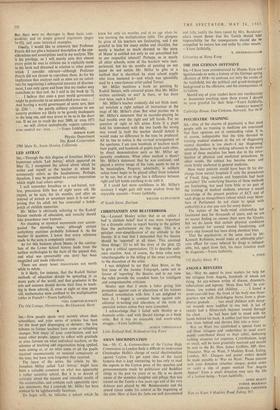SIR,—Few people speak very warmly about their schooldays; and your
series of articles has been for the most part disparaging or derisive: the few tributes to former teachers have come as refreshing changes. Not many of your contributors, and not many other people, appear to reflect with gratitude or even fairness on what individual teachers, or the schemes of teaching aad organisation being applied, were aiming at, or on what some or all the pupils received unconsciously, or received consciously at the time, but have now forgotten they received.
The latest of the series, the article by Mr. Jonathan Miller called 'Led Astray,' might have been a valuable comment on what was apparently a rather eccentric school. But it is so devoid of curiosity about the reasons and intended results of the eccentricities, and contains such apparently care- less statements, that I conclude Mr. Miller has been content to be lightheartedly facetious. To begin with, he ridicules a school which he
knew for only six months, and at an age when he was learning the multiplication table. The glimpses he gives of his teachers are fascinating, and I am grateful to him for many smiles and chuckles, but surely a teacher so much devoted to 'the story of Manu' is entitled not only to our astonished but to our respectful interest? Perhaps, as in nearly all other schools, some of the teachers were inex- perienced, but his six months of painting on wet paper do not entitle Mr. Miller to gibe at a method that is cherished by most school pupils who have mastered it—and which was splendidly used by a once-famous artist called Turner.
Mr. Miller mentions a book on painting by Rudolf Steiner, with coloured plates. Has Mr. Miller written carelessly or not? Is there, or has there ever been, such a book?
Mr. Miller's teacher evidently did not think musi- cal notation a right subject of instruction at the stage of Mr. Miller's class. But what puzzles me is Mr. Miller's statement that in recorder-playing he had trouble over the right and left hands. For no question of right or left arises. Even if a pupil held his instrument with the two hands the wrong way round (a fault the teacher should detect) it would make no difference to the tune he produced. All he has to notice is the vertical arrangement of the apertures. I am sure hundreds of teachers teach their pupils, and hundreds of pupils teach each other, by direct demonstration such as Mr. Miller ap- parently condemns. What other method is there? Mr. Miller's statement that he was confused, and played a mirror image of the tune, seems to me to be meaningless. Progress, admittedly, is unlikely unless tunes begin to be played either from notation or by ear, but at no stage has a difference between right and left hands anything to do with it.
If I could feel more confidence in Mr. Miller's accuracy I might gain still more wisdom from his enjoyable account.—Yours faithfully,














































 Previous page
Previous page